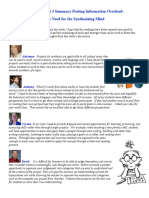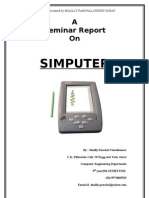Blank 2
Blank 2
Uploaded by
api-240432062Copyright:
Available Formats
Blank 2
Blank 2
Uploaded by
api-240432062Original Title
Copyright
Available Formats
Share this document
Did you find this document useful?
Is this content inappropriate?
Copyright:
Available Formats
Blank 2
Blank 2
Uploaded by
api-240432062Copyright:
Available Formats
Liz Arizona Eds 190 Fall 2013 November 22 2013 reflections Interactive modeling reflection: The interactive modeling
practice that I did with my third grade students at Balboa Elementary was having students model to the class how they would share their 'research' from their home projects with each other. I had 2 students, a boy and a girl, come up to the front of the class and ask each other a question from their worksheet. The first question was 'what happened', which the student answered in detail about. The second question was 'when did it happen', which the student didn't know the answer to. This was an interesting learning moment for the class. I explained to the student that if she didn't know the answer she could just say 'I don't know, my family did not tell me that'. When I asked students what they observed, students had typical observations about group work- such as they were facing each other, they were listening to each other, etc. However, they also noticed that the student who did not know was being honest about their answer. When I walked around and observed some discussions, I noticed that students were really being honest with each other in the answers and were respecting each other a lot. This interactive modeling practice helped the students to see a positive example of a group discussion, which is something that does not happen often in class. It was very successful and the kids enjoyed the process. Since my CT has adopted interactive modeling with the kids, they are used to the process now. They usually do interactive modeling 3-5 times a day and love it. I think it is very helpful for the kids to see the positive example first. They also really enjoy noticing things and sharing out. The classroom has been a much better place in terms of behavior due to our interactive modeling practices. 3:2:1- Interactive Modeling ch 5&6 Chapters 5 and 6 of Interactive Modeling provide excellent information regarding working with the interactive modeling technique to teach academic and social skills to students. One main idea I noticed is that interactive modeling is useful well beyond the transition/materials/ behavioral management portions of class (pg 105). Also, using this technique to teach concepts like math, reading, and social interaction can help students to internalize theses concepts. This is especially helpful for students who m ay not come from communities that emphasize topics like math in a students daily life. By seeing each other practice and model new academic concepts, students are able to embody or image themselves doing these as well. Lastly, a main idea seen in this text is that interactive learning is a tool that can be quite useful as a tool to accommodate different types of Learners, such as students with special needs, learning disabilities, English Language Learners and students who have not developed strong positive social skills (pgs 121,122,131). Some questions I have from this weeks readings are: how can I use the assertiveness interactive modeling lesson to show students when it is ok to use these skills, and when they should step back instead? Also, I like that the authors talked about using differentiation to adapt these lessons to the classroom. However, I have a very broad range of students in my class. How can I differentiate these lessons for my classroom, specifically for my autistic student? Something I will take from this weeks reading is the lesson adaptation to have students model mistaken assumptions made about each other and correcting the other mistakes.
You might also like
- Stakeholder Role (Related To Project) Involvement Impact EngagementDocument2 pagesStakeholder Role (Related To Project) Involvement Impact Engagementrajverma10in200286% (14)
- Emotional Intelligence Questionnaire by Dalip SinghDocument12 pagesEmotional Intelligence Questionnaire by Dalip Singhhalleyworld86% (7)
- Fracture Classifications in Clinical Practice PDFDocument132 pagesFracture Classifications in Clinical Practice PDFAkbar Khan100% (1)
- Storage Section in WMDocument7 pagesStorage Section in WMmbraghumb9019No ratings yet
- Case Study-DifferentiationDocument3 pagesCase Study-Differentiationapi-110862443No ratings yet
- Tws ReflectionsDocument9 pagesTws Reflectionsapi-296414448No ratings yet
- PostobservationgenderDocument3 pagesPostobservationgenderapi-355595959No ratings yet
- Module 4 Critical Thinking Option 2Document8 pagesModule 4 Critical Thinking Option 2api-355277655No ratings yet
- Tuning Protocol Maddie Bartlett 1Document27 pagesTuning Protocol Maddie Bartlett 1api-741712394No ratings yet
- Field Experience 2Document4 pagesField Experience 2api-742943826No ratings yet
- SMC DI Course Culminating Project - Solids and LiquidsDocument41 pagesSMC DI Course Culminating Project - Solids and Liquidssorensonvt5377No ratings yet
- Reflection 1Document10 pagesReflection 1api-735238723No ratings yet
- Four Levels of ReflectionDocument4 pagesFour Levels of ReflectionAmirah Izzati Nor AzamNo ratings yet
- Part 1: Analysis of Lesson Plan As WrittenDocument5 pagesPart 1: Analysis of Lesson Plan As Writtenapi-457047589No ratings yet
- Discussions To Reply ToDocument6 pagesDiscussions To Reply ToandyNo ratings yet
- Lesson Week ReflectionDocument13 pagesLesson Week Reflectionapi-733590777No ratings yet
- Observations at Sunset Park High School Decastro, Daniel Teacher'S College at Columbia UniversityDocument7 pagesObservations at Sunset Park High School Decastro, Daniel Teacher'S College at Columbia UniversitysarahschlessNo ratings yet
- Reflective Teaching: Exploring Our Own Classroom Practice: Conceptual Mapping 2 Copies of Each PageDocument5 pagesReflective Teaching: Exploring Our Own Classroom Practice: Conceptual Mapping 2 Copies of Each PageSaima AbediNo ratings yet
- Tws 6 Reflection Educ 329Document9 pagesTws 6 Reflection Educ 329api-176512276No ratings yet
- Social Studies Lesson 1Document8 pagesSocial Studies Lesson 1api-302238442No ratings yet
- Purcell CasestudyprojectDocument8 pagesPurcell Casestudyprojectapi-200557012No ratings yet
- Field Exp-Part 3Document3 pagesField Exp-Part 3api-511512490No ratings yet
- School Experience Reflection Journal 2Document6 pagesSchool Experience Reflection Journal 2api-272317458No ratings yet
- Ued496 Angela Tortora Artifact CDocument8 pagesUed496 Angela Tortora Artifact Capi-262598106No ratings yet
- Classroom Management Plan and ScriptDocument19 pagesClassroom Management Plan and Scriptapi-302270555No ratings yet
- Reflective Practice What Why and HowDocument7 pagesReflective Practice What Why and HowtracycwNo ratings yet
- The Top 5 Behaviour Management Strategies That Have Worked For MeDocument6 pagesThe Top 5 Behaviour Management Strategies That Have Worked For MemeugechNo ratings yet
- Erikas CMPDocument13 pagesErikas CMPapi-460192131No ratings yet
- Annotated Classroom Management PlanDocument6 pagesAnnotated Classroom Management PlanbloomuhuskieNo ratings yet
- Edu221 Philosophy PaperDocument6 pagesEdu221 Philosophy Paperapi-535069797No ratings yet
- EDIM 508 Unit 3 Summary Posting Information Overload: The Need For The Synthesizing MindDocument4 pagesEDIM 508 Unit 3 Summary Posting Information Overload: The Need For The Synthesizing MindktitraceNo ratings yet
- Learning EnvironmentsDocument7 pagesLearning Environmentsapi-621531450No ratings yet
- Folio CaseDocument5 pagesFolio Caseapi-350665428No ratings yet
- Teacher InterviewDocument3 pagesTeacher Interviewapi-352320073No ratings yet
- Prezentacja1 2Document15 pagesPrezentacja1 2api-413143545No ratings yet
- Philosophy of Education Final Draft 1Document8 pagesPhilosophy of Education Final Draft 1api-458812392No ratings yet
- Bramley BP 7Document4 pagesBramley BP 7api-328474438No ratings yet
- Artifact 3 - Course Reflection - Cep891 Summer 2014Document6 pagesArtifact 3 - Course Reflection - Cep891 Summer 2014api-315333936No ratings yet
- Fs 4 Ep1 DoneDocument4 pagesFs 4 Ep1 Doneapi-307697134No ratings yet
- Task One Ginna WeatherfordDocument3 pagesTask One Ginna Weatherfordapi-212499894No ratings yet
- Imbreflection 3Document2 pagesImbreflection 3api-295254879No ratings yet
- School Experience Reflection Journal Generaled 250Document6 pagesSchool Experience Reflection Journal Generaled 250api-284809101No ratings yet
- Barry Leung Action Research AssignmentDocument12 pagesBarry Leung Action Research Assignmentapi-449650944No ratings yet
- Constructivist Discipline For A Student-Centered ClassroomDocument6 pagesConstructivist Discipline For A Student-Centered ClassroomRajesh MajumdarNo ratings yet
- Part One Portfolio Piece Licensure Jasper Lynch Edited 1 1Document12 pagesPart One Portfolio Piece Licensure Jasper Lynch Edited 1 1api-565572798No ratings yet
- Haynes Natalie - Personal Teaching Philosophy ReflectionDocument2 pagesHaynes Natalie - Personal Teaching Philosophy Reflectionapi-474705852No ratings yet
- Goals of EducationDocument11 pagesGoals of EducationSteffanie Fate Aguanta LapuzNo ratings yet
- Smith - Classroom Management and Communication PlanDocument10 pagesSmith - Classroom Management and Communication PlanAnonymous 4Xq08NdCBNo ratings yet
- Coloquio Práctica Mariela ZayasDocument3 pagesColoquio Práctica Mariela ZayasMariela ZayasNo ratings yet
- Understanding Students Is Very Important To TeachingDocument6 pagesUnderstanding Students Is Very Important To TeachingMhango Manombo RexonNo ratings yet
- LBS 405 JournalsDocument3 pagesLBS 405 JournalsJonnell Knox-SmithNo ratings yet
- English Position PaperDocument6 pagesEnglish Position Paperapi-302583371No ratings yet
- Education 580 Artifact DescriptionDocument5 pagesEducation 580 Artifact Descriptionapi-304529596No ratings yet
- A-VED 311-Requirements For Midterm - Mrs. Condeza PDFDocument15 pagesA-VED 311-Requirements For Midterm - Mrs. Condeza PDFgenelyn gunoNo ratings yet
- Philosophy of Education PaperDocument5 pagesPhilosophy of Education Paperapi-308501431No ratings yet
- Portfolio - Section TwoDocument14 pagesPortfolio - Section TwoRachel DNo ratings yet
- Section On1Document31 pagesSection On1api-279598265No ratings yet
- Borkowski Lesson 2 SaDocument4 pagesBorkowski Lesson 2 Saapi-268656580No ratings yet
- Tws 8 Lesson ReflectionsDocument10 pagesTws 8 Lesson Reflectionsapi-212739686No ratings yet
- Psych FinalDocument6 pagesPsych Finalapi-245810041100% (1)
- Week 2Document3 pagesWeek 2api-302003110No ratings yet
- Classroom Managment Plan 2Document14 pagesClassroom Managment Plan 2api-509849143No ratings yet
- Quick Student Engagement Ideas for Busy Teachers: Creative Ideas From 1000 Remarkable Faculty & StudentsFrom EverandQuick Student Engagement Ideas for Busy Teachers: Creative Ideas From 1000 Remarkable Faculty & StudentsRating: 4 out of 5 stars4/5 (4)
- Internship Report UblDocument103 pagesInternship Report UblAngel Best100% (4)
- Durablue d25Document184 pagesDurablue d25arturoNo ratings yet
- PTE Listening Content For WebsiteDocument6 pagesPTE Listening Content For WebsiteBarodianbikerniNo ratings yet
- How Architecture Fails in Conditions of Crisis: A Discussion On The Value of Interior Design Over The COVID-19 OutbreakDocument3 pagesHow Architecture Fails in Conditions of Crisis: A Discussion On The Value of Interior Design Over The COVID-19 OutbreakTati Moreira LoorNo ratings yet
- Edinet Communicator Comprehensive B2B Integration ServicesDocument7 pagesEdinet Communicator Comprehensive B2B Integration ServicesMirela CojocNo ratings yet
- Zsigmond The Amanitaceae in Hungarian Folk TraditionDocument14 pagesZsigmond The Amanitaceae in Hungarian Folk TraditionÁgnes Piroska MágiKaNo ratings yet
- TRABAJO DE TIEMPOS VERBALES (Actividad Nro. 01)Document7 pagesTRABAJO DE TIEMPOS VERBALES (Actividad Nro. 01)Utisca, CA. Servicio Tecnico de Archivos RodantesNo ratings yet
- Reuse of FoundationsDocument35 pagesReuse of Foundationspetrohasan100% (2)
- R MullerDocument17 pagesR MullerEstherNo ratings yet
- 04AP Physics C - Capacitance and DielectricsDocument16 pages04AP Physics C - Capacitance and DielectricsJs ChongNo ratings yet
- Cambridge English Empower Empower A2 Reading Plus Teacher U11 WorksheetDocument1 pageCambridge English Empower Empower A2 Reading Plus Teacher U11 WorksheetrickNo ratings yet
- DirectionsDocument2 pagesDirectionsAbdul Azis Elnury100% (3)
- Raphael Nkwabi Vs Naomi Lucas Mbuki (Consolidated Civil Appeals No 95 113 of 2021) 2024 TZCA 572 (17 July 2024)Document8 pagesRaphael Nkwabi Vs Naomi Lucas Mbuki (Consolidated Civil Appeals No 95 113 of 2021) 2024 TZCA 572 (17 July 2024)clarenceNo ratings yet
- ParagraphsDocument11 pagesParagraphsnamanNo ratings yet
- Edgar - Opera Journeys Libretto SeriesDocument34 pagesEdgar - Opera Journeys Libretto SeriesIvan HockleyNo ratings yet
- MS in Quantitative Finance (MQF) SPJIMR.Document8 pagesMS in Quantitative Finance (MQF) SPJIMR.SPJIMRGMPNo ratings yet
- SimputerDocument19 pagesSimputerrock_000% (1)
- The Law On Obligations and Contracts - Reviewer / Memory AidDocument21 pagesThe Law On Obligations and Contracts - Reviewer / Memory Aidmj de Castro100% (1)
- Powerhouse English PracticeDocument90 pagesPowerhouse English PracticeRonald CarniceNo ratings yet
- Gibilisco Chapter Test (Chap 9-18)Document9 pagesGibilisco Chapter Test (Chap 9-18)Iahhel FactoranNo ratings yet
- IBM WebSphere MQ For Iseries Best Practices Guide - Middleware NewsDocument18 pagesIBM WebSphere MQ For Iseries Best Practices Guide - Middleware NewskarthickmsitNo ratings yet
- Ambix 1 - Issue 1.4Document13 pagesAmbix 1 - Issue 1.4Diogo CalazansNo ratings yet
- Mobily ProposalDocument6 pagesMobily ProposalshaimaaelgamalNo ratings yet
- The Character of A Happy Life by Sir Henry Wotton - Aral NoteDocument1 pageThe Character of A Happy Life by Sir Henry Wotton - Aral Noteayomiposi 2712No ratings yet
- Sum Academy Larkana MCQ Test Chapter 1 BiologyDocument9 pagesSum Academy Larkana MCQ Test Chapter 1 BiologyAli raza khero75% (4)
- Premarital Sex and Pregnancy I PDFDocument23 pagesPremarital Sex and Pregnancy I PDFRoyyan MursyidanNo ratings yet

























































































